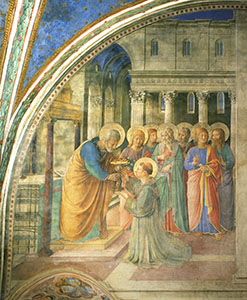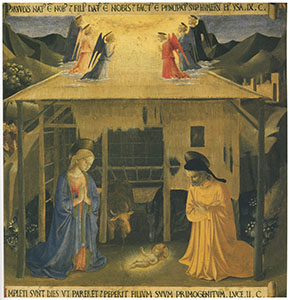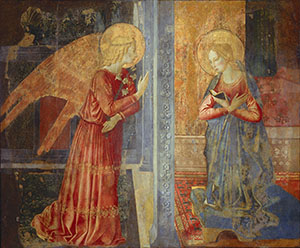
Saint Stephen Receives the Diaconate and Distributes Alms , Niccoline Chapel, Vatican Palace.

The Nativity from the Closet of Silver, Museum of Saint Mark, Florence.

The Annunciation, Narni Town Hall.
In 1447, sources document Benozzo’s presence in Rome, once again following Fra Angelico (Angelic Friar). On Epiphany in 1443, Pope Eugene IV had personally consecrated the Church of San Marco (Saint Mark) in Florence and, during his stay in the Tuscan city, he had had the chance to see and admire the works by the two painters. As a result, he commissioned them to carry out the most important and prestigious work that an artist could be called up to do at that time: the Cappella Maggiore (Greater Chapel) in the Vatican. Sadly, nothing now remains of these frescoes so it is impossible to determine the part played by the young Benozzo in their creation.
The painter then moved from Rome to Orvieto, with Fra Angelico (Angelic Friar), to work on a cycle of frescoes in that city’s Cathedral. They completed the decoration of two vault webs in the Chapel of San Brizio depicting the Choir of Prophets and the Christ the Judge surrounded by Angels. Further evidence of this commission is provided by documents indicating Benozzo as a "collaborator" of "il Beato Angelico" (the Blessed Angelic One), although his wage was considerably higher than that of the other assistants. Indeed, his reputation as an artist had grown considerably during that period. The other two webs, however, remained unfinished and, although Benozzo offered to finish them himself, the negotiations never reached a successful conclusion, perhaps due to the political problems that the city, and therefore the local economy, was experiencing at the time. The work was completed some fifty years later by Luca Signorelli (1499-1502).
After this brief stay in Orvieto, the two painters returned once again to Rome to paint the so-called Niccoline Chapel in the Vatican dedicated to the deacon martyr saints Stephen and Lawrence. In view of Benozzo’s proven experience at Fra Angelico’s (Angelic Friar) side and the documented substantial payments, the part he played in this work can be assumed to have been significant. Gozzoli’s stay in the capital (punctuated by his time in Orvieto) provided him with an opportunity for professional and cultural development, introducing him to the highly stimulating and fascinating environment that Rome was at that time, being a city where evocative late ancient models co-existed with new "modern" works of art. Indeed, painters and architects had come to the city to plan new monuments worthy of the capital of the Christian world at the wish of Pope Nicholas V, an ardent supporter of the new Renaissance spirit and Classical studies. Many of the works Benozzo produced for this "eternal city", cited by Vasari in his famous book on the biographies of artists, have been lost. However, a painting on silk (clearly part of a processional standard), which he created for the Basilica of Santa Maria Sopra Minerva depicting the Madonna and Child under a canopy, has survived. While it is painted according to medieval iconography, a series of devices - such as the Virgin’s mantle which overhangs the parapet - make this a strikingly modern work.
Scholars recognise Benozzo’s contribution to the panels that decorate the doors of a cupboard, known as the Closet of Silver, painted by "il Beato Angelico" (the Blessed Angelic One) for the small oratory annexed to the Chapel of the Santissima Annunziata in Florence, commissioned by Piero de’ Medici.
It has been established that these panels were created before 1453, when Fra Angelico (Angelic Friar) was once again called to Rome. It is therefore probable that Benozzo collaborated on the work during a brief trip to Florence before departing for the city of Montefalco in the Umbria region where he stayed from 1450 to 1452. In some of the works he produced during that period, as observed by Anna Padoa Rizzo, an eminent authority on the painter, Benozzo reuses certain stylistic motifs which he had tried out in the work on the Closet of Silver, and this would suggest that he was in Florence before 1450.
During this same period, Benozzo produced some frescoes for the Dominicans of Foligno and Narni. The artist may have felt obliged to accept these commissions as a result of his disappointment in Orvieto where, due to the political situation in the city at that time, he was unable to complete the decoration of the Cathedral. A few fragments of the first work are conserved in the Trinci Palace while the signed panel depicting the Annunciation is now housed in Narni Town Hall.
Serena Nocentini